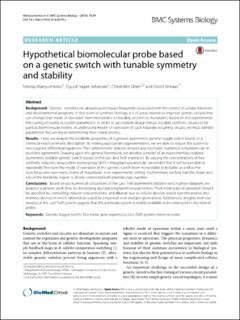| dc.contributor.author | Martyushenko, Nikolay | |
| dc.contributor.author | Johansen, Sigurd Hagen | |
| dc.contributor.author | Ghim, Cheol-Min | |
| dc.contributor.author | Almaas, Eivind | |
| dc.date.accessioned | 2020-06-09T07:09:47Z | |
| dc.date.available | 2020-06-09T07:09:47Z | |
| dc.date.created | 2016-11-09T10:06:16Z | |
| dc.date.issued | 2016 | |
| dc.identifier.citation | BMC Systems Biology. 2016, 10 (39), . | en_US |
| dc.identifier.issn | 1752-0509 | |
| dc.identifier.uri | https://hdl.handle.net/11250/2657266 | |
| dc.description.abstract | Background
Genetic switches are ubiquitous in nature, frequently associated with the control of cellular functions and developmental programs. In the realm of synthetic biology, it is of great interest to engineer genetic circuits that can change their mode of operation from monostable to bistable, or even to multistable, based on the experimental fine-tuning of readily accessible parameters. In order to successfully design robust, bistable synthetic circuits to be used as biomolecular probes, or understand modes of operation of such naturally occurring circuits, we must identify parameters that are key in determining their characteristics.
Results
Here, we analyze the bistability properties of a general, asymmetric genetic toggle switch based on a chemical-reaction kinetic description. By making appropriate approximations, we are able to reduce the system to two coupled differential equations. Their deterministic stability analysis and stochastic numerical simulations are in excellent agreement. Drawing upon this general framework, we develop a model of an experimentally realized asymmetric bistable genetic switch based on the LacI and TetR repressors. By varying the concentrations of two synthetic inducers, doxycycline and isopropyl β-D-1-thiogalactopyranoside, we predict that it will be possible to repeatedly fine-tune the mode of operation of this genetic switch from monostable to bistable, as well as the switching rates over many orders of magnitude, in an experimental setting. Furthermore, we find that the shape and size of the bistability region is closely connected with plasmid copy number.
Conclusions
Based on our numerical calculations of the LacI-TetR asymmetric bistable switch phase diagram, we propose a generic work-flow for developing and applying biomolecular probes: Their initial state of operation should be specified by controlling inducer concentrations, and dilution due to cellular division would turn the probes into memory devices in which information could be preserved over multiple generations. Additionally, insights from our analysis of the LacI-TetR system suggest that this particular system is readily available to be employed in this kind of probe. | en_US |
| dc.language.iso | eng | en_US |
| dc.publisher | BMC | en_US |
| dc.rights | Navngivelse 4.0 Internasjonal | * |
| dc.rights.uri | http://creativecommons.org/licenses/by/4.0/deed.no | * |
| dc.title | Hypothetical biomolecular probe based on a genetic switch with tunable symmetry and stability | en_US |
| dc.type | Peer reviewed | en_US |
| dc.type | Journal article | en_US |
| dc.description.version | publishedVersion | en_US |
| dc.source.pagenumber | 14 | en_US |
| dc.source.volume | 10 | en_US |
| dc.source.journal | BMC Systems Biology | en_US |
| dc.source.issue | 39 | en_US |
| dc.identifier.doi | 10.1186/s12918-016-0279-y | |
| dc.identifier.cristin | 1398630 | |
| dc.description.localcode | © 2016 Martyushenko et al.Open AccessThis article is distributed under the terms of the Creative Commons Attribution 4.0International License (http://creativecommons.org/licenses/by/4.0/), which permits unrestricted use, distribution, andreproduction in any medium, provided you give appropriate credit to the original author(s) and the source, provide a link to theCreative Commons license, and indicate if changes were made. The Creative Commons Public Domain Dedication waiver(http://creativecommons.org/publicdomain/zero/1.0/) applies to the data made available in this article, unless otherwise stated | en_US |
| cristin.ispublished | true | |
| cristin.fulltext | original | |
| cristin.qualitycode | 1 | |

